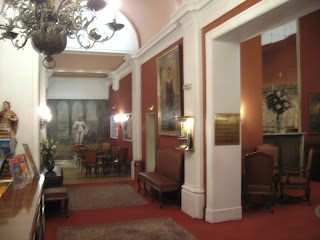It is Spy Wednesday and tomorrow begins the Oratory Triduum marathon! For those of you who are interested in what it is like to be in the Birmingham Oratory choir full time, I shall give you this schedule of our rehearsals and performances over the Sacred Triduum. Perhaps it may demolish a few popular myths about us...
Maundy Thursday
We start promptly for rehearsal at 5.30pm, for the mass of the Last Supper at 7.00pm. This means some of us have to leave straight after work. This lasts till 9.00pm. For me, I stay on to assist at Compline at the altar of repose, which finishes about 9.30pm.

There are some glorious highlights such as the Durufle Ubi Caritas at the offertory and Rebelo Panis Angelicus at communion, but the best bit for me is when we process with the Blessed Sacrament singing the chant Pange Lingua, and then we finish up singing the Victoria Mozamberic melody Tantum Ergo by the altar of repose. However, it's hard work!
Good Friday
This day is absolute murder! I join the Oratory Fathers on the sanctuary to help sing the Tenebrae at 8.30am, which lasts till about 10.45am. Then I have an hour break until I join everyone else in the choir for the first rehearsal at 11.45am, continuing until 1.00pm, starting again at 1.45pm and continuing up to the Good Friday liturgy itself at 3.00pm, which finishes at 4.30pm.

But we're not finished yet, and we can't go home! At 5.30pm we restart for the rehearsal for the Seven Last Words at 7.00pm, a service consisting of series of meditations, motets and devotions on the seven last words of our Lord. This is immediately followed by choral stations of the cross at 8.00pm, finishing at around nine o'clock in the evening. Only then can I rush home and have a bite to eat! In all, I'm singing from 8.30am in the morning till 9.00pm in the evening with a few short breaks.
Holy SaturdayAgain I turn up for Tenebrae at 8.30am, which is shorter this time and finishes about 10.00am. Then there is a respite to catch one's breath until the 7.00pm rehearsal for the Easter Vigil at 9.00pm, which lasts until about 11.30pm, one of the most dramatic services of the year, particularly the moment when the Gloria is intoned and the church is flooded with light. I join everyone else at the party afterwards, and then it is straight home to bed.

Easter Sunday
The High Mass rehearsal is at 9.00am, and High Mass is at 10.30am, lasting until 11.45am. Then it is off to have a four course Easter lunch with friends, to be back in the evening at 6.40pm for the Vespers rehearsal, with Solemn Vespers and Benediction at 7.30pm, finishing at 8.30pm with that very twee Regina Caeli by Ferdinand Schubert. (A piece widely believed by us to have been written by Franz Schubert's wife, not his brother.)

Here again is the
list of music we are doing: lots of it! I haven't put it up on this blog, because I haven't the time. And we have to sing all of it to professional standard, and in many cases sight read it from scratch. We are not an amateur choral society by any stretch of the imagination!
Not only that, over the last two weeks as choir librarian I have also been busy in preparations to get all the music for the services ready: we need at least twenty copies each. Thankfully, I have got most of this out of the way by now, or it would be complete chaos.















































